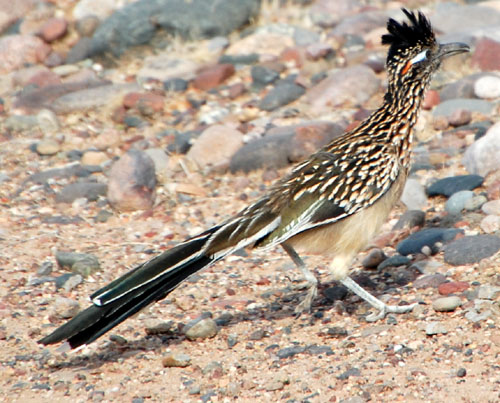It is said that there was once a time when Roadrunners were silent.
They were born into the Cuckoo family of birds, a disreputable start. Weirdness began at the toes, which in Cuckoos meant two facing forward and two facing backward. (Everyone knows a proper bird’s foot has three toes facing forward and one pointing behind. How else would you know if it was coming or going? I’m told Cuckoos don’t know either.) Add the fact that many Cuckoos accidently leave their eggs in other birds nests to be raised by those other birds and you can see how reputations might start. Roadrunners generally don’t do that, except to other Roadrunners, but if they were to start tomorrow, no one would be surprised.
All Cuckoos can fly, but Roadrunners forget how after about fifteen feet, so they took up walking or sprinting to get from place to place. In all fairness, they are a little large to fly too far, being about two feet in length and cursed with a bad hairdo that cuts down on aerodynamics considerably. Nevertheless, at a top speed of 15 MPH, they outrun even Whiptail Lizards, so they manage to eat.
Another thing that helps the eating is that pretty much anything smaller than they are is fair game. They eat cactus fruit, baby quail, snakes, small flying birds and large flying insects which they jump straight up and snatch in mid-air. If the prey has not had the grace to die of shock instantly, Roadrunners beat all heck out of whatever they’ve got in their bill against a rock until it stops moving. Then they whack it once or twice more for good measure and good tenderizing. Everything is so much easier to swallow after the spine has been shattered.
Because of their size and forgetfulness at flying, it was decided by Day and Night, the two primary creators, that Roadrunners would not have to migrate. They could stay put. Other Cuckoos have to migrate because they can fly between North and South America, a distinct advantage because there are a couple of large bodies of water to cross. Roadrunners don’t have to stay put, so long as they can walk there, which accounts for them being sighted in places like Kansas and Louisiana. What other reason could there be for being sighted in Kansas or Louisiana?
The point is, though, that all these travels and even the staying puts, were all done silently. Prey items were disappointed because they would have appreciated the warning, but Roadrunner parents were delighted.
All that changed, however, one morning, when Roadrunner kids were sitting in their nest, a little bored, frankly, waiting for Mom and Dad to deliver breakfast. One spontaneously bill-clacked for no apparent reason and without a bit of foreshadowing. You know how siblings are. Within five minutes they were all doing it and when Mom and Dad got home, they thought a bee hive had moved into the tree holding the nest because the whole place was buzzing. They quickly shoved the meals down the kids’ throats to shut them up, but it didn’t work for long. The kids kept buzzing, so the parents kept shoveling food. This is known as harassment.
It was only a matter of time before the kids came up with other sounds, including a cooing, not unlike a dove’s, unless you’re a dove. They thought it was a cool secret code, so secret even they didn’t know what it meant. The racket around the nest was pretty extreme by now, and could be heard by other nearby Roadrunner kids, who took up the habit and drove their parents crazy too.
To retaliate, the parents began whining before feeding the kids and pretty soon the kids expected chow whenever they heard the whine. When they got a little bigger, they tried to race each other toward the whining, to be the first to get the food from Mom or Dad. Eventually, parent Roadrunners whined to draw the kids away from the nest and out into the desert, where they lost them amongst the creosote bushes at the earliest possible moment, usually adolescence. It didn’t take long for all Roadrunner parents to learn this behavior, called positive reinforcement.
By this time, everyone knew Roadrunners could talk, though no one was ready to call it singing. Other Cuckoos were so embarrassed by their cousins’ strange vocalizations and pathetic family dynamics, they begged Day and Night to not have to associate with them and moved away from the desert. The Yellow-billed Cuckoos stayed, but only along the rivers and only for a couple of months. They migrated to Argentina as soon as their own kids could fly. They’d have gone farther south, but they ran out of land.
Desert lizards wished Roadrunners would leave too, even if only for Louisiana, but no such luck.

This Greater Roadrunner was busy chasing lizards along the gravely banks of the Salt River in Phoenix, Arizona.